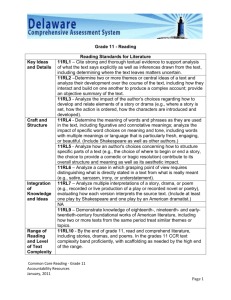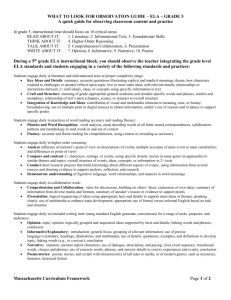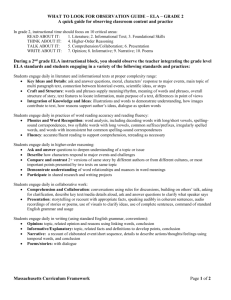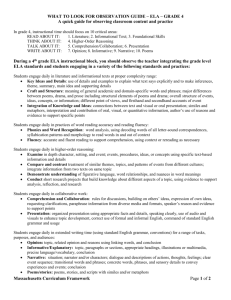Common Core State Standards Key Ideas and Details
advertisement
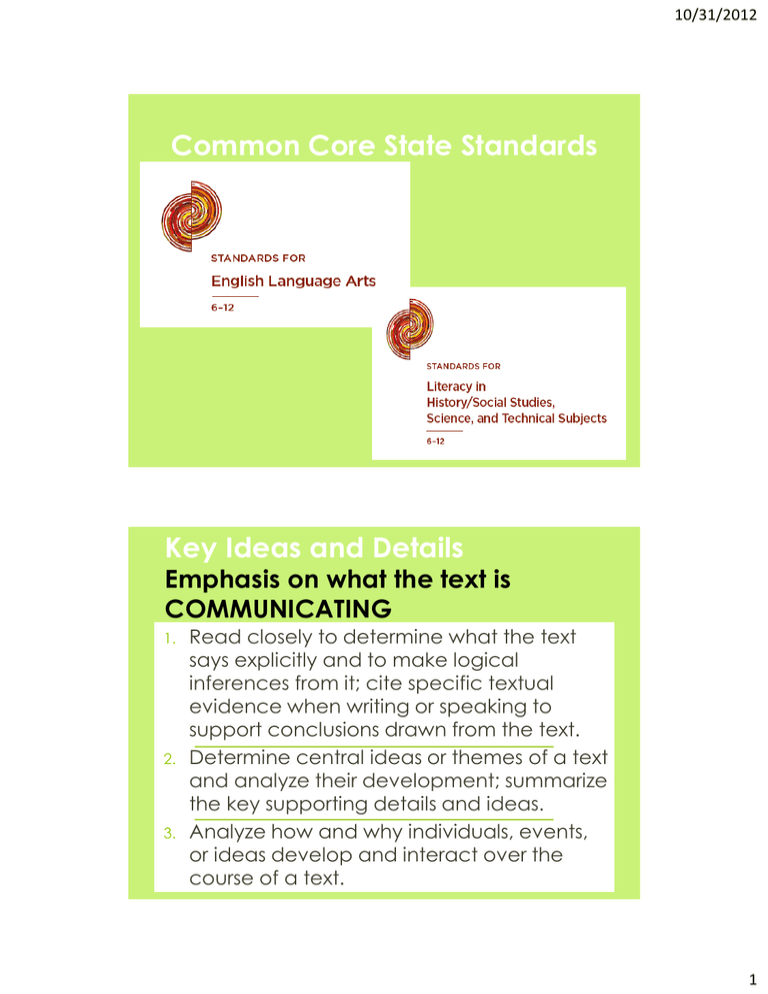
10/31/2012 Common Core State Standards Key Ideas and Details Emphasis on what the text is COMMUNICATING 1. 2. 3. Read closely to determine what the text says explicitly and to make logical inferences from it; cite specific textual evidence when writing or speaking to support conclusions drawn from the text. Determine central ideas or themes of a text and analyze their development; summarize the key supporting details and ideas. Analyze how and why individuals, events, or ideas develop and interact over the course of a text. 1 10/31/2012 Key Ideas & Details Standard 1 History Science ELA 1. Cite specific 1. Cite specific 1. Cite strong and textual evidence textual evidence thorough textual to support to support evidence to analysis of analysis of support analysis primary and science and of what the text secondary technical texts, says explicitly as sources, attending to the well as inferences attending to such precise details of drawn from the features as the explanations or text. date and origin of descriptions. the information. Key Ideas & Details Standard 2 History Science ELA 2. Determine the 2. Determine the 2. Determine a theme central ideas or central ideas or or central idea of a information of a conclusions of a text and analyze in primary source; text; trace the detail its provide an text’s development over accurate explanation or the course of the summary of how depiction of a text, including how key events or complex it emerges and is ideas develop process, shaped and refined over the course phenomenon, or by specific details; of the text. concept; provide an provide an objective summary accurate of the text. summary of the text. 2 10/31/2012 Key Ideas & Details Standard 3 History Science ELA 3. Analyze in detail a 3. Follow precisely a 3. Analyze how series of events complex multistep complex described in a procedure when characters (e.g., text; determine carrying out those with multiple whether earlier experiments, or conflicting events caused taking motivations) later ones or measurements, or develop over the simply preceded performing course of a text, them. technical tasks, interact with other attending to characters, and special cases or advance the plot exceptions or develop the defined in the text. theme. Craft and Structure Emphasis on how a text communicates MEANING 4. 5. 6. Interpret words and phrases as they are used in a text, including determining technical, connotative, and figurative meanings, and analyze how specific word choices shape meaning or tone. Analyze the structure of texts, including how specific sentences, paragraphs, and larger portions of the text (e.g., a section, chapter, scene, or stanza) relate to each other and the whole. Assess how point of view or purpose shapes the content and style of a text. 3 10/31/2012 Craft and Structure Standard 4 History Science ELA 4. Determine the 4. Determine the 4. Determine the meaning of words meaning of symbols, meaning of words and phrases as they key terms, and other and phrases as they are used in a text, domain-specific are used in the text, including analyzing words and phrases including figurative how an author uses as they are used in a and connotative and refines the specific scientific or meanings; analyze meaning of a key technical context the cumulative term over the course relevant to grades impact of specific of a text (e.g., how 11-12 texts and word choices on Madison defines topics. meaning and tone faction in Federalist (e.g., how the No. 10). language evokes a sense of time and place; how it sets a formal or informal tone. Craft and Structure History Standard 5 Science 5. Analyze in detail 5. Analyze how the how a complex text structures primary source is information or structured, ideas into including how key categories or sentences, hierarchies, paragraphs, and demonstrating larger portions of understanding of the text contribute the information or to the whole. ideas. ELA 5. Analyze how an author’s choices concerning how to structure a text, order events within it (e.g., parallel plots), and manipulate time (e.g., pacing, flashbacks) create such effects as mystery, tension, or surprise. 4 10/31/2012 Craft and Structure History 6. Evaluate authors’ differing points of view on the same historical event or issue by assessing the authors’ claims, reasoning, and evidence. Science 6. Analyze the author’s purpose in providing an explanation, describing a procedure, or discussing an experiment in a text, identifying important issues that remain unresolved. Standard 6 ELA 6. Analyze a particular point of view or cultural experience reflected in a work of literature from outside the United States, drawing on a wide reading of world literature. Integration of Knowledge & Ideas Emphasis on how meaning of the text and how texts are CONNECTED 7. 8. 9. Integrate and evaluate content presented in diverse formats and media, including visually and quantitatively, as well as in words. Delineate and evaluate the argument and specific claims in a text, including the validity of the reasoning as well as the relevance and sufficiency of the evidence. Analyze how two or more texts address similar themes or topics in order to build knowledge or to compare the approaches the authors take. 5 10/31/2012 Integration of Knowledge & Ideas Standard 7 History Science ELA 7. Integrate and evaluate multiple sources of information presented in diverse formats and media (e.g., visually, quantitatively, as well as in words) in order or address a question or solve a problem. 7. Integrate and evaluate multiple sources of information presented in diverse formats and media (e.g., quantitative data, video, multimedia) in order to address a question or solve a problem. 7. Analyze multiple interpretations of a story, drama, or poem (e.g., recorded or live production of a play or recorded novel or poetry), evaluating how each version interprets the source text, (include at least one play by Shakespeare and one play by an American dramatist) Integration of Knowledge & Ideas Standard 8 History Science 8. Evaluate an author’s 8. Evaluate the hypotheses, premises, claims, and data, analysis, and evidence by corroborating conclusions in a science or or challenging them with technical text, verifying the other information. data when possible and corroborating or challenging conclusions with other sources of information. 6 10/31/2012 Integration of Knowledge & Ideas Standard 9 History 9. Integrate information from diverse sources, both primary and secondary, into a coherent understanding of an idea or event, noting discrepancies among sources. Science ELA 9. Synthesize 7. Analyze how an information from a author draws on range of sources and transforms (e.g., texts, source materials in experiments, a specific work simulations) into a (e.g., how coherent Shakespeare understanding of a treats a theme or process, topic from Ovid or phenomenon, or the Bible or how a concept, resolving later author draws conflicting on a play by information when Shakespeare). possible. Range of Reading & Level of Text Complexity Emphasis on CHALLENGE of the text 10. Read and comprehend complex literary and informational texts independently and proficiently. 7
